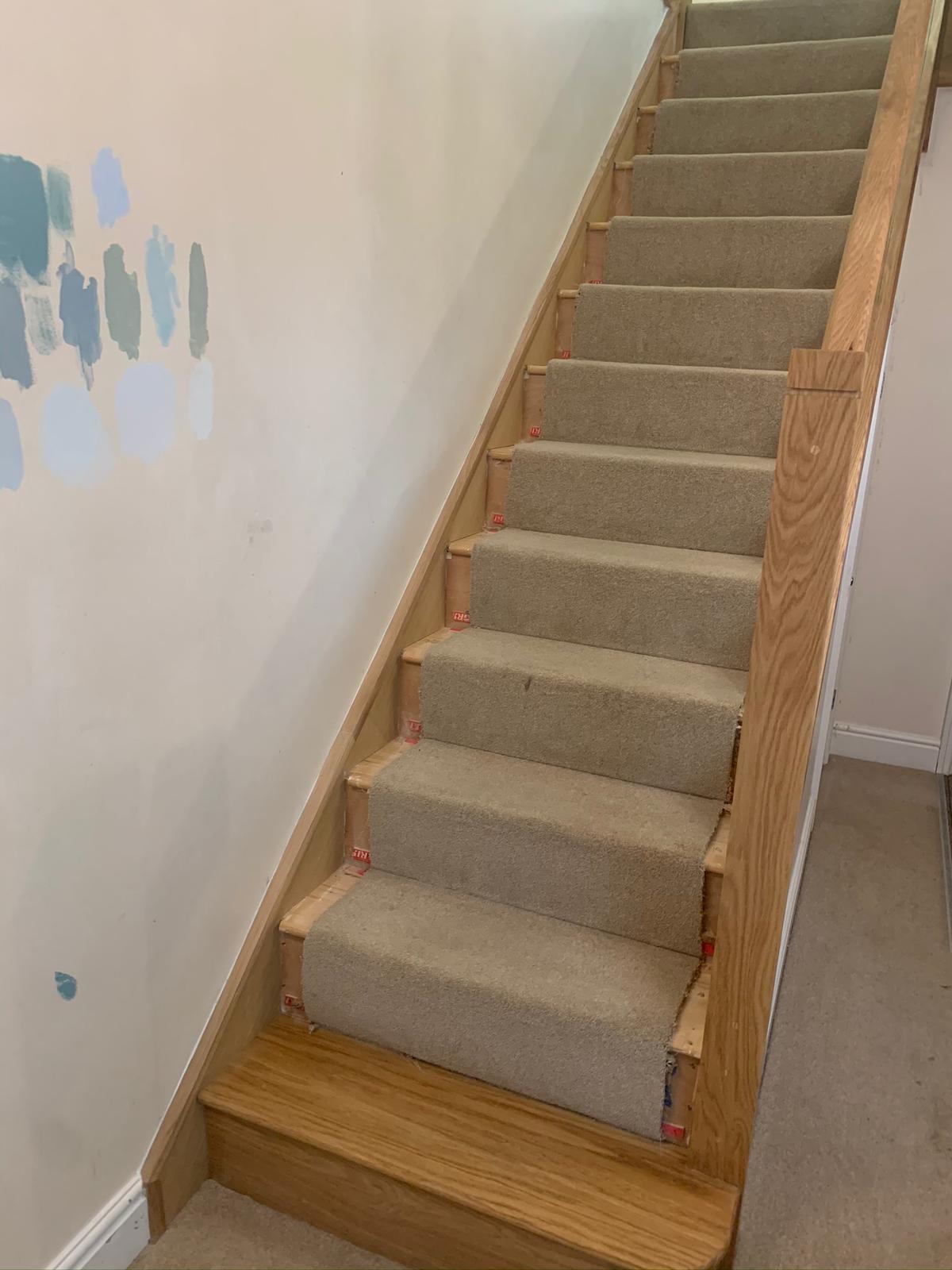
Refreshing your staircase can introduce a modern twist and create a lasting impression. As a first contact point, your stairs help set the tone for your home’s look and feel.
Renewing unsafe risers helps with security, but a new finish can also completely refresh the surrounding area.
Reviewing Your Current Staircase
You should know how your staircase relates to your home before you begin updating. Be sure to obtain consent from your local council if your property has listed status. Regular residences should still have staircases assessed for stability before any renovation. Consider what you’d like to achieve—can your present stairway cope with the level of renovation you have in mind?
Take time to consider your renovation goals and whether your stairway as it stands can cope with the plan.
Question whether your staircase is stable enough for the changes you’re planning.
Be clear on what you want to do and whether your stairway are able to support the work.
Does your staircase have the stability needed to handle the changes?
Before going ahead, consider whether your stairs can support your renovation ideas.
Understand your renovation plans and check if your staircase can safely handle the update.
Plan your renovation with your staircase’s current condition and strength in mind.
Will your current stairway work with the design changes you’re planning?
Consider carefully your design plans—can your current stairs support the renovation?
Older houses with classic stairways can often be brought back to life with DIY efforts, such as replacing treads or installing a stylish balustrade.
Older homes with wooden staircases can often be improved through DIY improvements like replacing the steps or handrails.
You can give timber stairs in older properties a fresh look by swapping out worn treads or installing a new railing.
Simple DIY upgrades like changing the steps or fitting a new handrail can enhance period staircases.
Wooden stairs in older homes often respond well to basic improvements like updating the steps or balustrade updates.
Many heritage steps can be enhanced with DIY projects, especially by updating the treads or banisters.
Wooden staircases in older houses often benefit from small changes like modern or classic balustrade additions.
Upgrading damaged stairs or adding a new balustrade can help bring a period staircase back to life.
If you have a traditional stair in a vintage house, some DIY work may be all it takes to refresh it.
Basic updates like renewing worn boards or adding a stylish railing can revitalise or improve a wooden staircase in a heritage house. For a major redesign, it’s advisable to talk to a pro early on, comparing the financial and design aspects of rebuilding entirely versus refurbishing.
If you're planning a major update, consult a staircase specialist early to evaluate starting fresh and restoring.
Large-scale renovations to your staircase should begin with guidance from a specialist to evaluate options and implications.
When considering a total makeover, a staircase expert can help you determine whether to replace completely or upgrade.
Before starting a major renovation, get a pro's opinion on whether to tear down and replace or work with the current setup.
A complete staircase overhaul should include professional insight to weigh the pros and cons of each option.
Talking to a staircase professional early can help you decide between a complete replacement or modernising what you have.
If a total renovation is on the table, balance the cost and design outcomes with help from a professional.
For major changes, it’s sensible to get advice from someone experienced in both renovation and reconstruction.
Plan carefully for a total overhaul by consulting a specialist and considering both routes.
When Do You Need Building Regs for a Stair Upgrade?
Before you start, find out what rules may impact your work. In many traditional homes, like-for-like replacements often don’t require full compliance with today’s regulations.
However, if altering the main shape of the staircase, you must follow Part K of the Building Regulations, which covers:
If you’re modifying the shape of your stairs, you’ll need to comply with Part K of the Building Regulations.
Making big changes to your staircase design means you must comply with Part K of the building rules.
Changing the staircase’s form or alignment requires you to meet the standards set in Part K of the building code.
If your renovation includes major alterations, you’re legally required to follow Part K standards.
Redesigning the form or layout of your staircase means it must follow the rules in Part K.
Part K of the Building Regulations applies when you make any major alterations to your staircase design.
Changing the entire layout of your stairs will mean adhering to strict rules under Part K.
Big changes to your staircase will need to meet the building rules set out in Part K.
You must stick to Part K standards if you’re changing how your staircase is laid out.
If your project involves altering the core design of your stairs, Part K regulations will come into effect.
- The law requires that each step has a horizontal depth of 220mm or more.
- To comply with Part K, your stair risers can’t be above 220mm.
- Keep nosings within the legal limit and make sure each tread is level.
- There should be at least 2m of space overhead, reduced to 1.8 metres for attic access.
- Part K requires that open tread staircases are designed so a 100mm ball can’t pass through the gap.
Before starting a project, get in touch with your local authority or a licensed builder for region-based regulations.
Giving Your Original Stairs a Fresh Look
Issues such as wobbly railings and squeaky stairs tend to come up during staircase updates. A wobbly balustrade may need glue and screws, or in some cases, extra support using a second stringer. Unsteady balustrades often need simple repairs, but sometimes a additional stringer is required for reinforcement. If creaking is due to loose fixings or deterioration, it may be fixable—unless the damage is too advanced. As long as the main structure is secure, chunky newel posts on traditional stairs can be resized for a neater finish.
Changing the Aesthetic of Your Stairway
A simple update might include fresh paint, modern stair boards, or even a stylish runner. If you lift the carpet, check for solid steps that can be cleaned up.
Planning to sand stair surfaces? Check for lead first and use safety gear if needed. Covered staircases should be checked underneath for rot or restoration opportunity. Expert support can ensure detailed work is done correctly and that stripped wood receives the appropriate treatment.
What’s Better for You: Stair Repair or a Full Replacement?
A complete stair rebuild might be the better option if your current one needs frequent repairs. Installing a similar staircase is quick—altering the layout isn’t. Always involve a structural engineer when working on stairs—they support more than just foot traffic.
Designing Your Stairs: What to Keep in Mind
You can choose from a range of designs like cantilevered, open, spiral, or floating designs. Think about who’s using the stairs—if it’s toddlers or elderly people, choose lower risers and avoid exposed gaps. A professional assessor can evaluate the area and advise on the best design. Staircase changes don’t just affect the stairs—they alter nearby areas, so you’ll benefit from professional insight.
How Stair Renovation Costs Add Up
Comparing several estimates with itemised costs help you spot differences and choose wisely. While DIY may reduce upfront spending, you still need to budget for gear and clean-up.
Inspiration for Modern Railing Designs
A single rail suffices for narrow stairs, but handrails must be installed on both sides if the staircase is broader. You’ll often see balustrades made of glass, aluminium, or oak in both modern and classic homes.
Toughened glass creates a clean look and boosts natural light, though the final cost depends on the choice of fixings.
Making the Staircase Part of Your Design Vision
Decide if you want your staircase to blend quietly with your interior or serve as a statement piece. Popular pairings include dark stairs with modern glass features, or oak rails in grey schemes.
Unifying your timber finishes across rails and door trims offer a neat finish, enhanced further with metallic touches.
Maximising Storage Below the Stairs
- Adding a cloakroom under the staircase can improve daily use—just make sure to get professional guidance.
- Use that spare space for sliding drawers to keep coats and shoes out of sight.
- Make a statement with a light-enhanced wine feature beneath your staircase.
- Design a Home Office – Install a custom-built desk with shelves, with a neat sliding door finish.
Transform the space into a compact work area with a fitted desk and storage.
Use the area for a neat workstation—add organisers and a tidy door front to keep it neat.
A small desk and shelving unit under the stairs makes a great tucked-away workspace.
Fit a tailor-made workstation under the stairs, complete with panel doors to hide the space.
Create a hidden desk setup by installing a desk and storage behind sliding panels.
Add a made-to-measure desk and shelves to make a practical workspace in unused space.
Design a mini office in the space with fitted furniture and hide it with sliding doors.
A fitted desk and storage area under the stairs is check here perfect for working from home.
Use custom-built furniture to build an efficient home office setup with sliding door panels.
Turn unused stair space into a home office with shelves, a desk, and sliding door cover. - Open up your kitchen by extending into the stair zone—perfect for seamless design flow.
Inspired Lighting Solutions for Your Stairs
Illuminated steps improve movement and awareness while bringing a polished look. What are your options?:
- Lighting recessed into the stairs provides a subtle and modern effect.
- Lighting the wall at foot level is a great way to guide movement in style.
- Overhead lights offer safe navigation and a sleek design finish.
Find lights that suit your design and offer soft, safe illumination.
In Conlusion:
A smartly designed staircase upgrade can boost both your home's appearance and daily functionality. Whether refreshing the existing structure or going for a full rebuild, the best plan will ensure lasting appeal and functionality.
 Jaleel White Then & Now!
Jaleel White Then & Now! Ariana Richards Then & Now!
Ariana Richards Then & Now! Michelle Pfeiffer Then & Now!
Michelle Pfeiffer Then & Now! Monica Lewinsky Then & Now!
Monica Lewinsky Then & Now! Christy Canyon Then & Now!
Christy Canyon Then & Now!